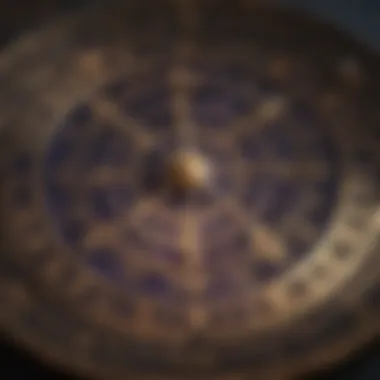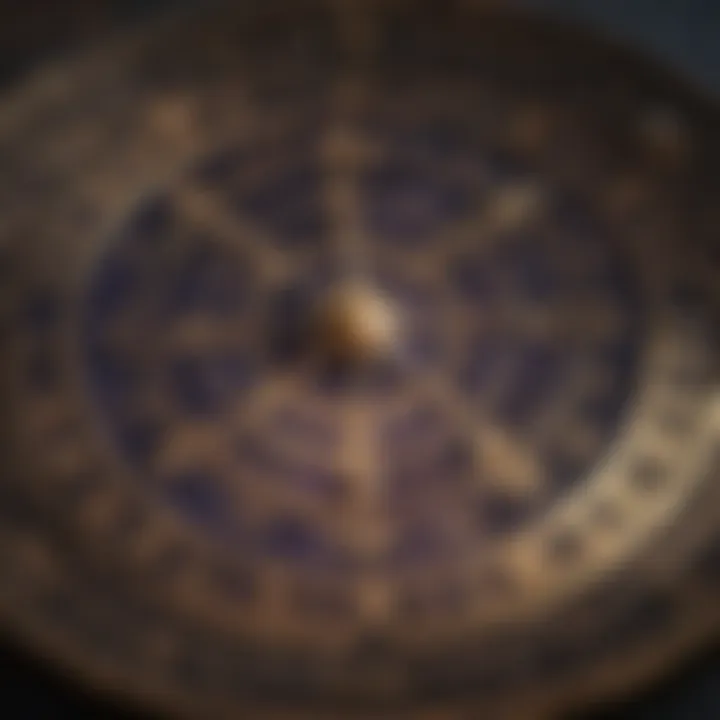Personal Birth Chart Analysis: Your Astrological Blueprint


Intro
Astrology is a fascinating subject that evokes curiosity and wonder about our place in the universe. Personal birth chart analysis offers an insightful lens to understand oneself and navigate life's complexities. Your birth chart serves as a unique map, based on the exact time and location of your birth, revealing the positions of celestial bodies such as planets and stars. Each of these placements carries meaning, shedding light on your personality, strengths, challenges, and potential life path.
By examining your birth chart, you can gain a clearer picture of various aspects in life. This exploration not only aids in personal growth but also enhances relationships and decision-making processes. The significance of understanding your astrological blueprint cannot be understated. This article delves deeper into different components of your birth chart analysis, guiding you through the intricate world of astrology. We'll begin with an overview of the Zodiac, moving onwards to astrological insights and horoscope predictions.
Understanding the Zodiac
Overview of Zodiac Signs
The Zodiac is divided into twelve signs, each corresponding to specific dates and reflecting distinct personality traits. These signs can be seen as archetypal energies influencing human behavior and experience. Understanding the significance of each sign is a key step in interpreting a birth chart.
- Aries - The pioneer, bold and energetic.
- Taurus - The sensualist, grounded and reliable.
- Gemini - The communicator, curious and adaptable.
- Cancer - The nurturer, intuitive and emotional.
- Leo - The performer, charismatic and confident.
- Virgo - The analyst, detail-oriented and practical.
- Libra - The diplomat, sociable and fair-minded.
- Scorpio - The transformer, passionate and intense.
- Sagittarius - The explorer, adventurous and optimistic.
- Capricorn - The achiever, disciplined and responsible.
- Aquarius - The innovator, original and humanitarian.
- Pisces - The dreamer, compassionate and artistic.
Sign Traits and Characteristics
Each sign exhibits unique traits and characteristics. These qualities shape how individuals express themselves and interact with others. Some traits may manifest more strongly, depending on other factors in the birth chart such as rising signs and moon signs.
Understanding these traits can provide insights into personal conflicts, relationship dynamics, and career choices.
Elemental Qualities
The Zodiac signs are also categorized into four elements: Fire, Earth, Air, and Water. Each element further defines the nature of the signs.
- Fire Signs (Aries, Leo, Sagittarius) are passionate and dynamic.
- Earth Signs (Taurus, Virgo, Capricorn) are practical and reliable.
- Air Signs (Gemini, Libra, Aquarius) are intellectual and communicative.
- Water Signs (Cancer, Scorpio, Pisces) are emotional and intuitive.
Recognizing these elemental qualities provides another layer of understanding when analyzing your birth chart.
Astrological Insights
Current Astrological Trends
Astrology is not static; it evolves with time. Being aware of current trends helps individuals relate their personal experiences to broader celestial movements. Various transits and aspects formed between planets affect collective experiences. For instance, during a Mercury retrograde period, communication often faces challenges, which can be reflected in an individual's interactions.
Influence of Celestial Events
Celestial events such as eclipses, full moons, and precise planetary alignments carry unique implications. These events can highlight specific areas in one’s birth chart, bringing opportunities for growth or reflection. By recognizing when these events occur, individuals can prepare for their impact on personal lives.
How to Interpret Your Birth Chart
Interpreting a birth chart can feel complex, but it can be manageable with practice. Key components include:
- Planets: Represent various aspects of personality.
- Signs: Indicate how these planetary energies are expressed.
- Houses: Reflect specific areas of life affected by these energies.
Using reliable resources, such as books on astrology and online tools, enables a more refined approach to chart reading.
Horoscope and Predictions
Monthly or Weekly Forecasts
Horoscopes often serve as a compact interpretation of upcoming celestial influences. Monthly or weekly forecasts provide insights into potential opportunities and challenges, serving as a guide through daily life events. Readers can utilize these forecasts to better navigate daily encounters.
Personalized Horoscope Reading
A personalized horoscope reading takes individual birth charts into account, offering tailored insights. This individualized approach reveals profound aspects of personality and potential experiences unique to the person. By analyzing transits, progressions, and current planetary positions, a deeper narrative unfolds.
Compatibility Readings Based on Zodiac Signs


In relationships, understanding compatibility according to Zodiac signs offers valuable insights. Different signs interact in varied ways; some may naturally harmonize, while others might face challenges. These dynamics often provide a deeper understanding of relationships and partnerships.
Intro to Personal Birth Charts
Personal birth charts are often described as the unique maps of the cosmos at the moment of one's birth. They hold significant importance in astrology, serving as a foundation for understanding individual traits, tendencies, and life paths. In this article, we will explore the components of a birth chart, how to read it, and ways to use this knowledge for personal growth.
What is a Birth Chart?
A birth chart, also known as a natal chart, is a detailed diagram that captures the positions of celestial bodies at the exact time and location of a person's birth. The chart includes the Sun, Moon, and planets as well as the astrological houses and aspects between these celestial bodies.
Each celestial body represents different aspects of personality and life events. For example, the Sun reflects core identity and ego, while the Moon symbolizes emotions and instincts. By analyzing these elements, we gain insights into ourselves, revealing both strengths and challenges.
The layout of a birth chart can be complex. It involves aspects like the twelve zodiac signs, which are classified into elements and modalities, and the twelve houses, which signify different life areas. Successfully interpreting this chart can help individuals understand their intrinsic motivations and life narratives.
Purpose of Birth Chart Analysis
Birth chart analysis serves many valuable purposes. First, it enables self-discovery. By examining their birth chart, individuals can uncover unique traits and tendencies. Knowing these attributes can be empowering, fostering better self-acceptance and personal growth.
Additionally, the chart provides insights into relationships. By comparing birth charts, one can grasp compatibility and potential challenges between individuals. This aspect is particularly useful in romantic partnerships, friendships, and professional collaborations.
Understanding a birth chart can also guide career choices. Certain planetary placements may suggest aptitudes for specific professions. For example, a strong presence of planets in the tenth house may indicate a natural inclination toward leadership or public roles.
In essence, birth chart analysis not only lays out an astrological blueprint but also serves as a practical tool. It allows individuals to navigate challenges and harness their strengths. Just as every individual has a unique fingerprint, their birth chart is equally distinctive, offering insights tailored to each person's journey.
Components of a Birth Chart
The significance of understanding the components of a birth chart lies at the heart of astrological analysis. Each individual’s birth chart serves as a cosmic fingerprint, revealing distinct patterns and influences shaped by the positions of celestial bodies at the moment of one’s birth. By examining these components, one unlocks insights into personality traits, life challenges, and potential paths for personal development.
The primary components include the zodiac signs, planets, houses, and aspects. Together, they create a detailed backdrop against which life unfolds. Each element contributes uniquely to the overall astrological narrative, making a comprehensive birth chart analysis essential for an enriched understanding of oneself and others.
Zodiac Signs and Their Traits
Zodiac signs represent the twelve distinct segments of the celestial sphere and correspond to twelve different archetypes. Each sign imparts specific characteristics that influence a person’s behavior and motivations. For example, Aries embodies assertiveness and dynamism, while Pisces is known for intuition and empathy.
When analyzing zodiac signs in a birth chart, consider the sun sign, moon sign, and rising sign. This triplet provides a nuanced view of an individual’s identity. The sun sign reflects core self-identity, the moon sign offers insight into emotional inner life, and the rising sign represents outward personality as perceived by others.
Planets and Their Influences
The planets in a birth chart are not merely celestial bodies; they symbolize various aspects of human experience. Each planet governs specific domains in one’s life. For instance, Venus influences love and relationships, while Mars is associated with ambition and drive.
In birth chart analysis, one must examine the placements of planets within different signs and houses. The relationship between these placements helps pinpoint areas where an individual might thrive or face challenges. Additionally, the movement of planets over time, known as transits, further affects how these influences are experienced.
Houses and Their Meanings
The astrological houses divide the birth chart into twelve areas, each representing different aspects of life, from relationships to career. The first house signifies self-image and identity, while the seventh house pertains to partnerships and marriage.
Understanding which planets occupy which houses can offer substantial insight. For instance, if Jupiter is in the fourth house, it may indicate favorable growth related to family and home life. In this way, houses serve as frameworks that influence specific life experiences based on the planetary placements.
Aspects and Their Significance
Aspects refer to the angles formed between planets in the chart, indicating how these celestial bodies interact with each other. Understanding aspects is crucial as they reveal the dynamics at play in an individual’s life.
For example, a conjunction suggests a strong alignment and blending of energies, while a square indicates tension or conflict. Common aspects include trines, sextiles, squares, and oppositions, each showcasing a different facet of planetary interactions. Assessing these relationships can inform how various traits and tendencies manifest in daily life.
"The true essence of a person is often revealed in the interplay of the components within their birth chart."
Through this multi-faceted analysis, one gathers a richer understanding of astrological influences, paving the way to personal insights that promote growth and self-awareness.
Reading Your Birth Chart


Reading your birth chart is crucial in understanding the essence of your astrological profile. It is not just about knowing your sun sign; rather, it requires delving into the intricate locations and relationships of celestial bodies at the moment of your birth. Through this process, you can uncover insights about your personality, motivations, challenges, and life paths. Thus, this section will illuminate the importance of reading your birth chart, while also addressing some key elements involved.
Locating Key Elements
To begin, identifying key elements in your birth chart is a fundamental step. Typically, these include your sun sign, moon sign, and rising sign. The sun sign, representing your core identity, is generally what people refer to as their zodiac sign. The moon sign relates to your emotions and inner world, while the rising sign, or ascendant, depicts how you present yourself to the world.
Other essential factors encompass the position of planets, as well as their placements across different houses. Each house represents various aspects of life, such as relationships, career, and personal growth. By pinpointing these elements, you can gain a clearer understanding of how they intertwine to form your unique blueprint.
Interpreting Planetary Positions
Next is the interpretation of planetary positions. Each planet holds distinct meanings and influences that color your birth chart. For instance, Venus is associated with love and aesthetics, while Mars relates to energy and assertiveness. The placement of these planets within the houses will tell you how their powers manifest in your life.
Consider where your planets are located: Are they concentrated in a few houses, or are they spread out? This distribution can speak volumes about the areas in your life that will be more prominent or challenging. Understanding these details helps to develop a more thorough interpretation of your astrological influences.
Understanding House Placements
The significance of house placements cannot be overstated. Each house represents different facets of life. For example, the first house relates to self-image and personal beginnings, while the seventh house concerns partnerships and relationships. The placement of planets within these houses can impact how events unfold in those specific areas of your life.
To make the most of this information, it is vital to explore which houses contain significant planets and how they interact with one another. This will refine your understanding of astrological influences and their direct relation to your everyday experiences and decisions.
Examining Aspects Between Planets
Finally, examining aspects between planets provides further insights. Aspects refer to the angles formed between planets. They are categorized into several types, such as conjunctions, squares, and trines. Each type holds a different weight and significance, influencing how the energies of the planets interact.
For example, a conjunction may suggest a blending of energies, producing heightened intensity in the areas each planet governs. Conversely, a square may indicate tension and challenges needing resolution. By examining these aspects, you unveil deeper layers of your astrological identity and its implications.
Understanding your birth chart is a journey of self-discovery that can transform your perspective on life's challenges and opportunities.
In summary, reading your birth chart allows for extensive exploration of your astrological landscape. By locating key elements, interpreting planetary positions, understanding house placements, and examining aspects, you can extract meaningful insights that can guide you throughout your life.
Utilizing Your Birth Chart
Understanding how to utilize your birth chart can offer profound insights into various aspects of life. The knowledge gained from analyzing your astrological blueprint can serve as a guiding light. By navigating through your astrological placements, you can harness the potential within for self-exploration and personal development.
Self-Discovery and Personal Growth
The process of self-discovery is crucial. When you analyze your birth chart, you are not just looking at planetary placements or zodiac signs; you are unlocking facets of your personality. Each element in your chart can reveal motivations, strengths, and weaknesses.
- Identifying Strengths: Understanding your core abilities allows you to enhance these traits.
- Recognizing Weaknesses: Awareness of challenging aspects can lead to personal growth.
- Emotional Insight: Your chart can shed light on how you manage emotions and relationships, offering a pathway to emotional intelligence.
Engaging with these insights encourages deeper reflection and can help shape your approach to life events. For many, the birth chart becomes a mirror, reflecting authentic self-identity.
Relationship Compatibility Insights
The astrological chart is not merely about individual traits; it also offers rich insights into relationships. By comparing your chart with another’s, you may discern compatibility and potential challenges.
Key aspects to consider:
- Synastry: This technique involves overlaying two charts to analyze relationship dynamics. Examining aspects between the two charts can indicate areas of harmony and friction.
- Composite Charts: These charts synthesize two individual charts into one, presenting the relationship as a whole.
- Essential Compatibility Factors: Different signs, houses, and planetary placements can affect compatibility. Understanding these can lead to better communication and connection.
Astrology gives unique perspectives on how we relate to others, fostering compassion and understanding in connections.
Career Path Guidance
Astrological insights can also illuminate professional paths. Your birth chart can indicate natural inclinations toward certain careers based on celestial placements.
Factors to examine include:


- Midheaven or 10th House: This area of the chart represents career ambitions and public life. Studying the sign and any planets in this house provides crucial insights.
- Second House: This relates to personal values and income. Analyzing its ruler can reveal how you can generate wealth.
- Planetary Influences: The placement of planets like Mercury, Venus, and Mars can indicate communication style, creativity, and assertiveness in a work setting.
By utilizing the insights from your birth chart, you can align your professional endeavors with your inherent talents.
Understanding your birth chart is a powerful tool for personal transformation, shaping both personal growth and interpersonal relationships, as well as guiding career choices to achieve fulfillment.
In summary, using your birth chart effectively allows for meaningful connections with oneself and others, enriching the journey of life. Whether you seek personal development, harmonious relationships, or a fulfilling career, your birth chart serves as a valuable resource.
Common Misconceptions in Astrology
Misunderstandings about astrology often cloud its true nature and significance. These misconceptions can lead to hasty judgments and dismissals that overlook the depth and complexity of the practice. Recognizing and addressing these misunderstandings is crucial for anyone looking to explore personal birth charts. Understanding common misconceptions enhances a person's ability to engage with astrology in a more meaningful way.
Astrology as a Science
One prevalent misconception is that astrology is purely a pseudoscience. While astrology does not follow the rigorous methods of experimentation characteristic of natural sciences, it possesses its own system of logic and reasoning. Astrology examines patterns and correlations between celestial bodies and human experiences. Each position of a planet or star is believed to symbolize distinct influences that manifest in various aspects of life. Although astrology lacks empirical validation like sciences such as physics, many practitioners argue that it provides a framework for understanding human experience and behavior.
Proponents contend that astrology, when applied properly, can offer insights into personality, relationships, and life choices. Many individuals find value in this ancient practice, whether or not it aligns with traditional scientific principles. It is essential to acknowledge the large historical context in which astrology developed. Throughout centuries, it has played a significant role in various cultures, from guiding monarchs in ancient civilizations to influencing contemporary personal development.
Difference Between Astrology and Astronomy
Another common misunderstanding is conflating astrology with astronomy. Although both fields share a foundation in the study of celestial bodies, their objectives and methods diverge significantly. Astronomy is a natural science focused on observing and understanding celestial phenomena. It involves the study of stars, planets, and galaxies through data collection and analysis using technology and rigorous methodologies.
Astrology, in contrast, interprets the influence of celestial bodies on human affairs. Astrologers analyze birth charts and planetary positions to derive meanings and insights about individuals and events. Here are a few key differences between the two:
- Objective: Astronomy seeks to understand the universe using empirical evidence, while astrology aims to derive personal meanings from cosmic patterns.
- Methodology: Astronomy relies on quantitative data and scientific experimentation. Astrology uses interpretive frameworks based on symbolism and tradition.
- Applications: Astronomy serves fields like physics and space exploration. Astrology often guides personal reflection and self-discovery.
It is vital to appreciate that both astronomy and astrology offer valuable insights, albeit in distinct realms. Both fields require a deep understanding of celestial phenomena. However, conflating them leads to misunderstandings that can hinder exploration in either domain.
Astrology offers a unique lens through which individuals can interpret their experiences while recognizing that it operates alongside scientific principles, not necessarily against them.
Tools for Birth Chart Analysis
Understanding the tools for birth chart analysis is essential for anyone interested in astrology. These tools facilitate deeper insights into personal astrological blueprints and allow for nuanced interpretations of celestial influences. By utilizing technology and expert guidance, individuals can enhance their level of understanding and practical application of their birth charts.
Online Chart Generators
Online chart generators are valuable resources for those looking to create their birth charts quickly and efficiently. Many websites offer these generators for free or at a minimal cost. To utilize these tools, users generally need to input their birth date, time, and location. After processing this data, the generator produces a visual representation of one's astrological chart, displaying the positions of zodiac signs, planets, and houses.
Some notable online chart generators include AstroSeek and Astrodienst. These platforms not only create charts but also provide basic interpretations. However, users should be cautious, as not all generators offer comprehensive insights. The quality of interpretation can vary significantly. It is important to cross-reference the information with trusted sources or professional insights.
Astrological Software
Astrological software packages provide deep analytical capabilities beyond what online generators can offer. They often contain a more extensive array of features, including transit analysis, compatibility scoring, and progressions. Programs like Solar Fire and Kepler are popular among professional astrologers. These tools allow for detailed chart calculations and enable users to explore complex astrological concepts at greater depth.
Astrological software often includes user-friendly interfaces, making it accessible to those at different levels of expertise. Additionally, many programs give users the ability to save charts for later analysis, enhancing the user experience. However, potential users should consider their specific needs and preferences when selecting a software program, as there can be a significant learning curve.
Consulting Professional Astrologers
Consulting professional astrologers is an excellent approach for those seeking personalized and detailed interpretations of their birth charts. Professional astrologers can provide insights that automated tools cannot replicate. They use their expertise to consider the subtle nuances of each chart, interpreting aspects that may be overlooked in standard analyses.
During a consultation, individuals can discuss specific areas of interest, such as personal development or relationship dynamics. The expertise offered by professional astrologers can help individuals understand their placements and transits in greater detail. It's important to seek astrologers with positive reviews and a clear understanding of one's astrological needs.
Closure
Astrology, often regarded as a mere belief system, holds a deeper significance in understanding human behavior and personal experiences. This article emphasizes the importance of personal birth chart analysis as a means of self-exploration and enlightenment. The ability to interpret celestial formations allows individuals to align more closely with their intrinsic nature, enhancing self-awareness and paving the way for personal growth.
The Continued Relevance of Astrology
Astrology remains relevant in contemporary society despite scientific skepticism. It serves as a reflective tool, helping individuals to navigate their lives with intention. Rather than providing definitive answers, astrology encourages personal interpretation of experiences. By examining one's birth chart, one can glean insights into motivations, fears, and aspirations. This introspective journey cultivates a deeper understanding of relationships, career choices, and overall life paths. The metaphysical principles of astrology resonate with many, creating a bridge between ancient wisdom and modern self-discovery.
Encouragement to Explore Personal Birth Charts
Diving into the richness of one’s personal birth chart offers an opportunity for profound insight. It is not merely about predicting future events but also about understanding the underlying energies that shape one’s existence. Individuals are encouraged to take a closer look at their celestial map, paying attention to the positions of the planets, signs, and aspects. Each chart is unique, telling a story that reveals strengths and potential challenges. By engaging in this exploration, one can foster a sense of empowerment and clarity.
"Your birth chart is a roadmap to your soul, representing your unique essence and life journey."







